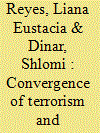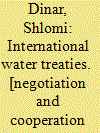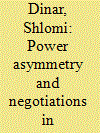|
|
|
Sort Order |
|
|
|
Items / Page
|
|
|
|
|
|
|
| Srl | Item |
| 1 |
ID:
081962


|
|
|
|
|
| Publication |
New Jersey, World Scientific Publishers, 2007.
|
| Description |
vii, 458p.Hbk
|
| Series |
World scientific series on energy and resource economics; vol. 3
|
| Standard Number |
9789812568939
|
|
|
|
|
|
|
|
|
|
|
|
Copies: C:1/I:0,R:0,Q:0
Circulation
| Accession# | Call# | Current Location | Status | Policy | Location |
| 053594 | 627.1/DIN 053594 | Main | On Shelf | General | |
|
|
|
|
| 2 |
ID:
110814


|
|
|
|
|
| Publication |
2012.
|
| Summary/Abstract |
In the existing 276 international river basins, the increase in water variability projected by most climate change scenarios may present serious challenges to riparian states. This research maps the institutional resilience to water variability in transboundary basins and combines it with both historic and projected variability regimes, with the objective of identifying areas at potential risk of future hydropolitical tension. To do so, it combs existing international treaties for sources of institutional resilience and considers the coefficient of variation of runoff as a measure of past and future water variability. The study finds significant gaps in both the number of people and area covered by institutional stipulations to deal with variability in South America and Asia. At present, high potential risk for hydropolitical tensions associated with water variability is identified in 24 transboundary basins and seems to be concentrated mainly in northern and sub-Saharan Africa. By 2050, areas at greatest potential risk are more spatially dispersed and can be found in 61 international basins, and some of the potentially large impacts of climate change are projected to occur away from those areas currently under scrutiny. Understanding when and where to target capacity-building in transboundary river basins for greater resilience to change is critical. This study represents a step toward facilitating these efforts and informing further qualitative and quantitative research into the relationship between climate change, hydrological variability regimes, and institutional capacity for accommodating variability.
|
|
|
|
|
|
|
|
|
|
|
|
|
|
|
|
| 3 |
ID:
138896


|
|
|
|
|
| Summary/Abstract |
This article examines the convergence among ethnic groups, narco-traffickers, insurgents, and terror organizations in Central Asia. It analyzes the lucrative business of drug trafficking and the diffusion of globalization, which have undoubtedly brought these once disparate groups together. It will explore how the increasing movement of illicit goods and people, proliferation of transportation technology, growing infrastructure, cooperative ethnicities, as well as a shared need for funding, have provided these groups with an opportunity to consolidate their efforts in ways that were not possible in the past.
|
|
|
|
|
|
|
|
|
|
|
|
|
|
|
|
| 4 |
ID:
188062


|
|
|
|
|
| Summary/Abstract |
Building on a global research sweep of terrorist organizations’ (as well as other non-state actors such as separatist and insurgent groups) use of fresh water as a target, weapon, or source of control, this paper analyzes attacks on major water projects (specifically dams and other related infrastructure) in South Asia—the region identified to have had the largest number of recorded water-related violent incidents. Focusing on India, Pakistan, and Afghanistan, and the post 9/11 period through 2019, the paper explores how large water infrastructures (and their environs) have become hot spots for violence between states that use water development projects to consolidate power, garner local loyalty, and create a national narrative and non-state actors who attempt to target these same projects to assert indigenous self-determination, subvert state power, or challenge state authority through terrorist means. Since fresh water is shared across borders, dam projects can become entangled in regional political disputes further exacerbating violent conflict between state and non-state actors. Given its impacts on water resources, climate change may act as a “threat multiplier” by enhancing local grievances, providing both government and terrorist groups additional incentives for exploitation, and further contributing to instability. The analysis provided here borrows from and contributes to the fields of development, environment and security, and terrorism studies.
|
|
|
|
|
|
|
|
|
|
|
|
|
|
|
|
| 5 |
ID:
183009


|
|
|
|
|
| Summary/Abstract |
Terrorist organizations destabilize governments through violent and coercive acts that include the use of water resources as a target. Scholars in security studies recognize water as a strategic resource but have yet to systematically quantify and describe how water is used in the case of terrorism. This paper explores this gap at the nexus of the larger fields of terrorism and environmental security by offering methods to codify types of water-related terrorism events. Using the University of Maryland’s Global Terrorism Database, which includes information on terrorist events around the world, and employing aggregate data analysis, we highlight trends over time and space. We found that water-related terrorism is a method of terrorism widespread across most of the world and that water infrastructure is the main target of choice by most terrorist organizations. We identified 675 incidents of water-related terrorism that occurred in seventy-one countries. We identified terrorist organizations with the highest numbers of incidents and transboundary water basins most at risk for water-related terrorism incidents. This collective analysis identifies and codifies the number and type of water-related terrorism incidents that occurred from 1970 to 2016; describes spatial and temporal trends of those incidents; and provides information for decision-makers regarding water-related terrorism targets and associated risk.
|
|
|
|
|
|
|
|
|
|
|
|
|
|
|
|
| 6 |
ID:
081916


|
|
|
|
|
| Publication |
London, Routledge, 2008.
|
| Description |
xix, 344p.
|
| Standard Number |
9780415772082
|
|
|
|
|
|
|
|
|
|
|
|
Copies: C:1/I:0,R:0,Q:0
Circulation
| Accession# | Call# | Current Location | Status | Policy | Location |
| 053552 | 346.0432/DIN 053552 | Main | On Shelf | General | |
|
|
|
|
| 7 |
ID:
106934


|
|
|
| 8 |
ID:
088932


|
|
|
|
|
| Publication |
2009.
|
| Summary/Abstract |
Realist thinkers traditionally argue that when the upstream state is the river basin's hegemon, cooperation is least likely to materialize. Conversely, when the downstream state is the basin's hegemon, cooperation is likely to ensue, yet the agreement is often imposed and shaped along the interests of the stronger party. Implied in both scenarios is that the otherwise weaker riparian, in aggregate power terms, is not in a position to achieve its aims and satisfy its needs in an optimal fashion. Its capabilities are inferior to those of its adversary. In effect, it has little alternative but to accept the desires of the stronger riparian. By considering a set of international water agreements and hydro-political contexts, this article challenges the realist conception of power in international river basins. Particularly, it demonstrates that otherwise weaker states may influence the hydro-political context and subsequent international agreements. Cooperation, in general, materializes when both states, but particularly the stronger state, realize that benefits can accrue from coordination and joint action. In other words, to harness the river in an efficient manner, cooperation must ensue and the downstream state's participation is important. Even when the benefits to cooperation are not clear, i.e. when the upstream riparian does not foresee immediate economic incentives to cooperation, coordination may still be attained through the manipulation of incentives (or strategic interaction).
|
|
|
|
|
|
|
|
|
|
|
|
|
|
|
|
| 9 |
ID:
106935


|
|
|
|
|
| Publication |
2011.
|
| Summary/Abstract |
Water scarcity is popularly associated with inter-state conflict, yet the academic literature also touts scarcity as an important variable for understanding cooperation over international freshwater. Building on studies that consider the relationship between scarcity and hydro-political cooperation, this paper empirically investigates why water treaties are negotiated for some rivers and between some riparians, and not others. Rather than considering a linear relationship between scarcity and cooperation, this study hypothesizes a curvilinear relationship expecting agreements to emerge in situations where scarcity is moderate rather than very low or high. Additional variables considered for understanding treaty formation include level of governance among the riparian states, prevailing power dynamics along the river, overall inter-riparian relations (measured by trade, diplomatic ties, and militarized disputes), and the geographical configuration of the entire river. The hypothesized curvilinear relationship between water scarcity and cooperation finds significant support in the empirical analyses. Governance, diplomatic relations, and trade are likewise found to be salient in explaining the levels of cooperation. The geographical configuration of the river was significant in only part of the estimates, and the militarized disputes variable was found to be insignificant across all models. Finally, while results confirm that cooperation may not depend on power asymmetries within riparian dyads, as suggested by some theories, the paper does find support for the contention that more developed states are in a position to provide incentives, such as financial transfers, to less-developed states so as to facilitate an international agreement.
|
|
|
|
|
|
|
|
|
|
|
|
|
|
|
|
|
|
|
|
|